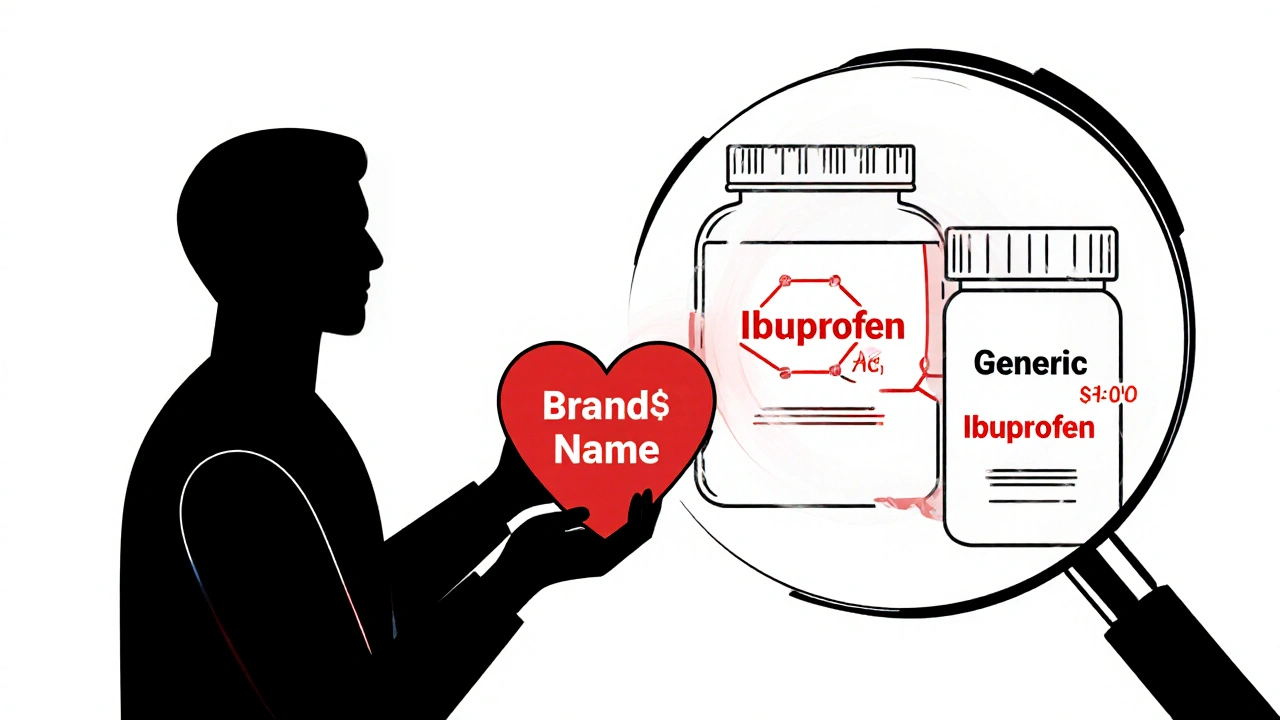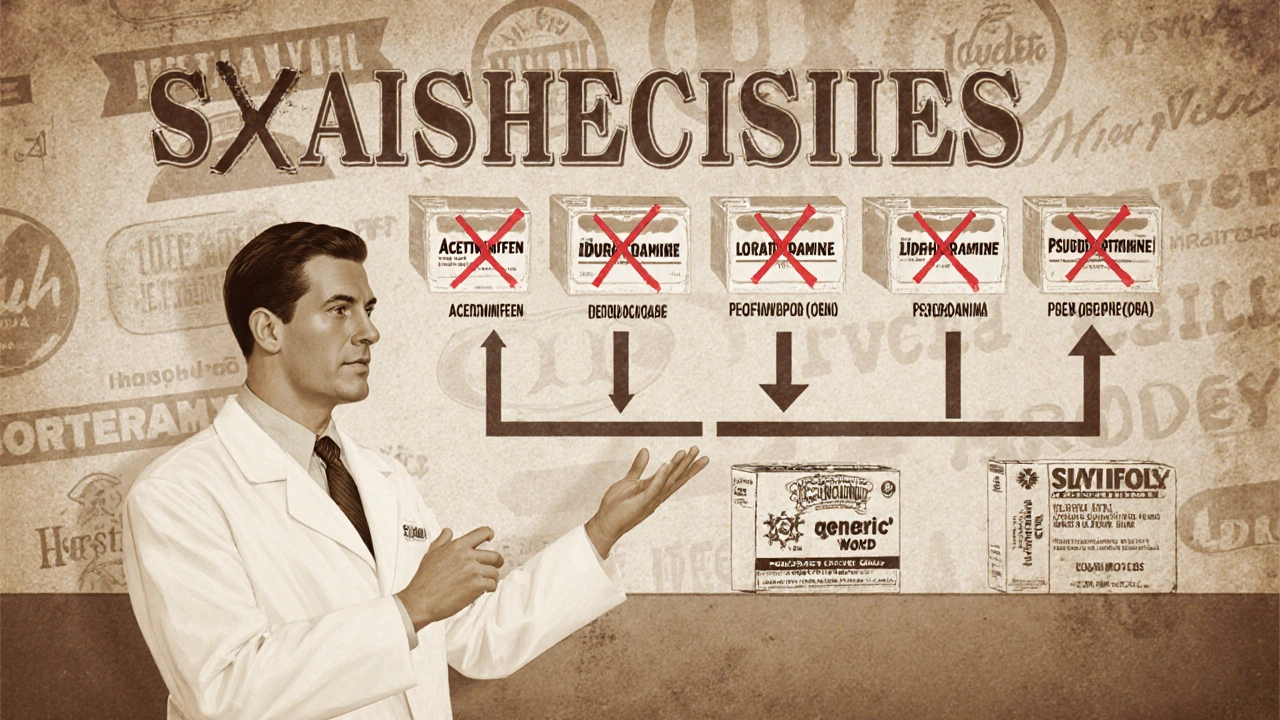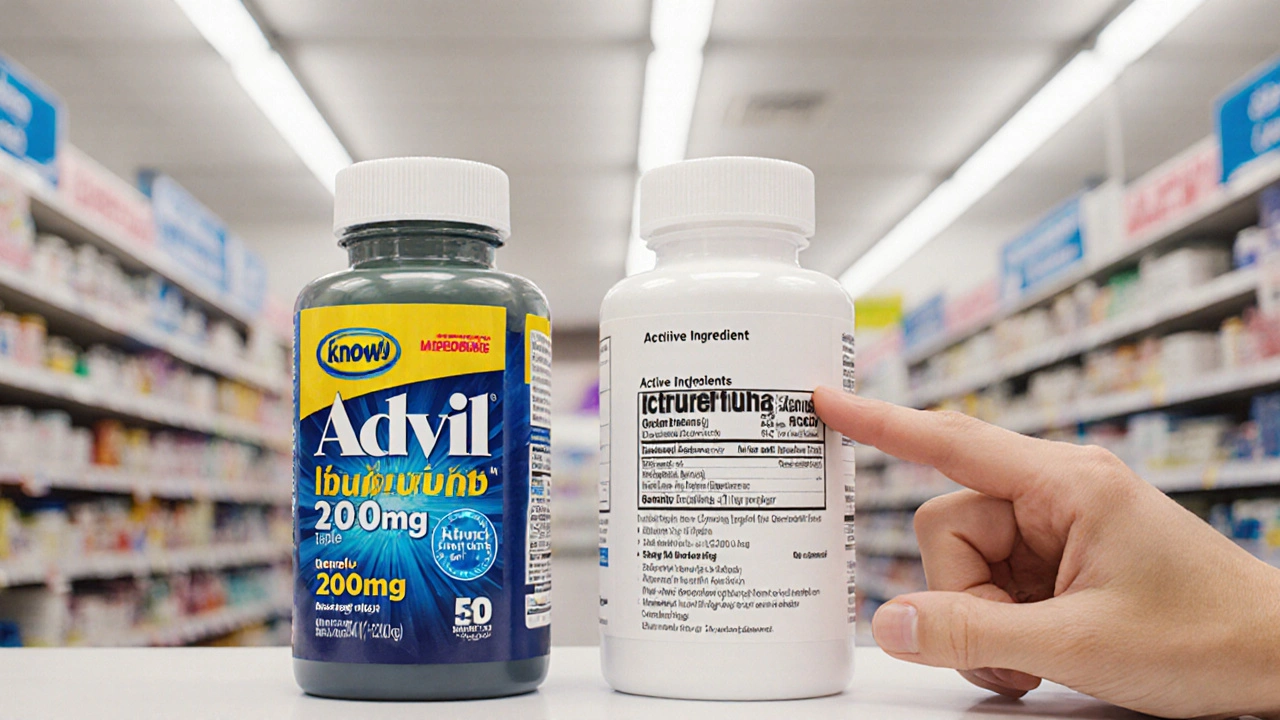Every time you walk into a pharmacy, you’re faced with shelves full of bottles and boxes with names you don’t recognize. One says Advil, another says Ibuprofen. Are they different? Should you pay more for the brand name? The truth is simple: active ingredient is the only thing that actually matters when choosing a drug.
What is an active ingredient?
The active ingredient is the chemical in a medicine that makes it work. It’s the part that interacts with your body to reduce pain, lower blood pressure, fight infection, or calm allergies. Everything else - the color, the shape, the brand name, the packaging - is just filler. Think of it like coffee: espresso, latte, and cold brew all have the same active ingredient - caffeine. The rest is just how it’s served.
For example, Tylenol and generic acetaminophen both contain the same active ingredient: acetaminophen. They work the same way. They’re dosed the same way. The only real difference? Price. The brand version might cost three times as much, but your body can’t tell the difference.
Why most people pick the wrong drug
Most people choose drugs based on advertising, habit, or what the pharmacist recommends without asking why. You’ve probably bought a brand-name drug because it was on sale, or because your mom always bought it, or because the commercial made it look better.
But here’s what happens: you pay more for the same effect. A 2023 study from the U.S. Food and Drug Administration found that 98% of generic drugs perform identically to their brand-name counterparts in clinical trials. That’s not a guess. That’s science.
Even more surprising? Many brand-name drugs are made in the same factories as the generics. The only difference is the label. A 2024 report from the Government Accountability Office showed that over 50% of brand-name medications in the U.S. are produced by companies that also make the generic versions.
How to read a drug label like a pro
Every medicine box or bottle has a section called the “Drug Facts” label. In the U.S., this is required by law. Look for the Active Ingredients line. That’s your golden ticket.
Here’s how to break it down:
- Find the word Active Ingredients - it’s usually near the top.
- Write down the name. It might be something like “loratadine” or “pseudoephedrine hydrochloride.”
- Ignore everything else: “for cold and flu,” “24-hour relief,” “clinically proven.” Those are marketing words.
- Go to the generic aisle and find the same active ingredient. Check the dosage. Match it.
Example: You see “Claritin” on the shelf. The active ingredient is loratadine. You find “Store Brand Loratadine” for $4 instead of $15. Same thing. Same results. Save $11.

Common active ingredients you should know
You don’t need to memorize every drug on the market. But knowing these five can save you hundreds a year:
- Acetaminophen - for pain and fever. Brand names: Tylenol, Paracetamol.
- Ibuprofen - for inflammation, pain, fever. Brand names: Advil, Motrin.
- Loratadine - for allergies. Brand names: Claritin, Alavert.
- Diphenhydramine - for sleep and allergies. Brand names: Benadryl, Sominex.
- Pseudoephedrine - for nasal congestion. Brand names: Sudafed, Clarinex-D.
These are the most common OTC (over-the-counter) drugs. If you take any of them regularly, you’re overpaying if you’re buying the brand name.
When brand names actually matter
There are exceptions. Not every drug is interchangeable. Some medications need precise dosing or delivery systems. For example:
- Thyroid medications like Synthroid (levothyroxine) - switching brands can affect your hormone levels. Always check with your doctor.
- Anti-seizure drugs like Lamictal (lamotrigine) - small changes in absorption can trigger seizures.
- Warfarin (blood thinner) - even tiny differences in how the body absorbs it can be dangerous.
For these, stick with the same brand unless your doctor says otherwise. But for 90% of OTC drugs - pain relievers, allergy meds, cold remedies - the generic is just as good.
How to save money without risking your health
Here’s a simple plan:
- Keep a small notebook or phone note with the active ingredients you use most.
- Next time you buy medicine, compare the active ingredient on the brand and generic labels.
- If they match, buy the generic. Always.
- Ask your pharmacist: “Is there a generic with the same active ingredient?” They’re trained to help you save money.
- Use pharmacy loyalty programs - many offer generics for $4 or less.
One woman in Ohio told me she switched from brand-name Zyrtec to generic cetirizine and saved $300 a year. She didn’t feel any different. Her allergies didn’t get worse. She just had more money in her pocket.

What about side effects?
Some people worry that generics cause more side effects. That’s a myth. The FDA requires generics to have the same active ingredient, strength, dosage form, and route of administration as the brand. They must also meet the same purity and stability standards.
The only difference? The inactive ingredients - things like dyes, fillers, or flavorings. These rarely cause issues. If you have a known allergy to a dye (like FD&C Red No. 40), check the full ingredient list. But for most people, it’s not a concern.
What if you’re on insurance?
Insurance plans often push generics because they’re cheaper. Many have tiered formularies - generics are usually Tier 1 (lowest cost), while brands are Tier 2 or 3 (higher copay). Your plan might even refuse to cover the brand unless your doctor writes a letter explaining why you need it.
Check your plan’s drug list. If the generic is covered and the brand isn’t - you don’t have a choice. But even if both are covered, the copay for the generic is often $5 vs. $40 for the brand.
Bottom line: Your body doesn’t care about the brand
You don’t need to be a pharmacist to choose the right drug. You just need to know one thing: active ingredient.
When you stop paying for the label and start paying for the chemical that works, you save money, reduce waste, and still get the same relief. It’s not complicated. It’s just not taught in ads.
Next time you reach for medicine, pause. Look at the label. Find the active ingredient. Compare. Choose. Save. Your wallet - and your body - will thank you.
Can I switch from a brand-name drug to a generic without asking my doctor?
For most over-the-counter drugs like pain relievers, allergy meds, or cold remedies, yes. You can switch to a generic with the same active ingredient without consulting a doctor. But for prescription drugs like thyroid medication, blood thinners, or anti-seizure drugs, always check with your doctor first. Small differences in how your body absorbs the drug can matter.
Are generic drugs less effective than brand-name drugs?
No. The FDA requires generic drugs to have the same active ingredient, strength, dosage form, and absorption rate as the brand-name version. In fact, 98% of generics perform identically in clinical studies. The only difference is cost - generics cost 80-85% less on average.
Why do generic drugs look different?
By law, generics can’t look exactly like the brand-name version. That’s why they have different colors, shapes, or markings. But those differences are only in the inactive ingredients - the dyes, fillers, or coatings. They don’t affect how the drug works. The active ingredient is identical.
How do I find the active ingredient on a drug label?
Look for the section labeled “Active Ingredients” on the Drug Facts label. It’s usually near the top. It will list the chemical name (like “ibuprofen”) and the amount per dose (like “200 mg”). Ignore all other claims like “fast-acting” or “clinically proven.” Those are marketing.
Is it safe to buy generic drugs from online pharmacies?
Only if the pharmacy is licensed and verified. In the U.S., look for the VIPPS seal (Verified Internet Pharmacy Practice Sites). Avoid websites that don’t require a prescription for prescription drugs, or that offer drugs at prices that seem too good to be true. Counterfeit drugs are a real risk - and they may contain no active ingredient at all, or dangerous substances.


Write a comment